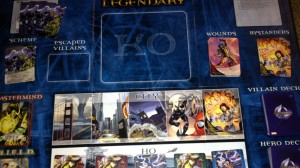This week’s Monday Night Gaming: Legendary, a Marvel Deck-Building Game.
 Publisher: Upper Deck Entertainment
Publisher: Upper Deck Entertainment
# of Players: 1-5 players
Best with: 3-4 players
Playing Time: 1st time through, 1 hour. After that, 40-60 minutes depending upon cards used.
# of Expansions: 7
# of Parts: Game board, rule book, and 500 cards (plus dividers for box).
With my love of deck-builders, my husband was only to happy to introduce me to Legendary. The game is set in the Marvel universe and pits heroes/good guys against villains–one mastermind villain who is the boss to beat and multiple smaller villains through the course of the game. Players can either specifically chose the heroes (like Spider-man, the Hulk, Wolverine, etc.) or chose them at random as well. The game varies greatly depending upon which of the fifteen heroes are chosen.
General Mechanics: Like most deck builders, players begin with a set hand of 12 specific cards. Over the game, players recruit heroes from headquarters which are added to their deck. HQ contains five heroes at any given time, and each one is replaced after being recruited. Like Dominion, what cards you add and play will change the game and thus, your strategy. Heroes give players a mix of attack power and recruitment power. Attack power allows players to defeat villains (including the boss). Some heroes give special effects or powers as well, such as giving additional attack power if played after particular cards or in combination with specific cards.
At the start of the turn, a player turns over a villain and adds it to The City, which has a limited number of spots (five) for villains. As villains are turned over, undefeated villains get pushed down the row, growing closer and closer to escape. If the five slots fill and another villain is pushed out of the row, they have escaped, which can end the game depending upon the number of escaped villains, who the mastermind villain is, etc.
Some villains have effects when they come into play, such as kidnapping bystanders. The villain’s deck also contains “master strikes,” which allows the mastermind villain to take a bonus action. This could give the players “wounds,” force them to discard important cards, or countless other actions–none of them good.
After the villain stage, players play cards from their hand of six, discard, and draw a new hand. They can recruit heroes and attack villains during their play stage.
If a player fights and defeats a villain, they collect the villain cards (and sometimes additional cards) that give them victory points. The harder the villain to defeat, the more points achieved. If a player fights the boss (mastermind villain), they retrieve a card from under the mastermind’s deck. This card usually gives a boon to the player.
How to Win/Lose: If the mastermind’s deck is empty due to players defeating him in battle, then the game is over and the heroes have won. Players will tally up their victory points to see who has won. (The game is both cooperative and competitive.) However, if the mastermind completes his scheme (usually through master strike cards, having a certain number of villains escape, or giving enough wounds to heroes), then the villains win and all players lose.
What I Liked: I love the Marvel them, but I also like how this deck-builder is both cooperative and competitive. It adds an extra dimension to the game play.
What I Didn’t Like: Honestly, nothing. While Sentinels just expected me to know which heroes and villains to use the first time through, Upper Deck Entertainment ensured that wasn’t an issue. All their Legendary games recommend a set of cards to use your first game through to ensure you aren’t overpowered in five minutes as you’re still learning the rules.
Overall Rating/Impression: 8.5/10.0 Awesome deck-builder.

